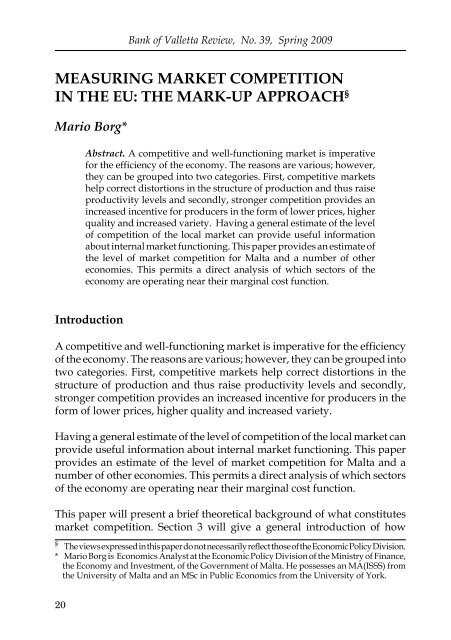MEASURING MARKET COMPETITION IN THE EU ... - Bank of Valletta
MEASURING MARKET COMPETITION IN THE EU ... - Bank of Valletta
MEASURING MARKET COMPETITION IN THE EU ... - Bank of Valletta
Create successful ePaper yourself
Turn your PDF publications into a flip-book with our unique Google optimized e-Paper software.
Mario Borg<br />
§ The views expressed in this paper do not necessarily reflect those <strong>of</strong> the Economic Policy Division.<br />
* Mario Borg is Economics Analyst at the Economic Policy Division <strong>of</strong> the Ministry <strong>of</strong> Finance,<br />
the Economy and Investment, <strong>of</strong> the Government <strong>of</strong> Malta. He possesses an MA(ISSS) from<br />
the University <strong>of</strong> Malta and an MSc in Public Economics from the University <strong>of</strong> York.<br />
20<br />
<strong>Bank</strong> <strong>of</strong> <strong>Valletta</strong> Review, No. 39, Spring 2009<br />
<strong>MEASUR<strong>IN</strong>G</strong> <strong>MARKET</strong> <strong>COMPETITION</strong><br />
<strong>IN</strong> <strong>THE</strong> <strong>EU</strong>: <strong>THE</strong> MARK-UP APPROACH §<br />
Mario Borg*<br />
Abstract. A competitive and well-functioning market is imperative<br />
for the efficiency <strong>of</strong> the economy. The reasons are various; however,<br />
they can be grouped into two categories. First, competitive markets<br />
help correct distortions in the structure <strong>of</strong> production and thus raise<br />
productivity levels and secondly, stronger competition provides an<br />
increased incentive for producers in the form <strong>of</strong> lower prices, higher<br />
quality and increased variety. Having a general estimate <strong>of</strong> the level<br />
<strong>of</strong> competition <strong>of</strong> the local market can provide useful information<br />
about internal market functioning. This paper provides an estimate <strong>of</strong><br />
the level <strong>of</strong> market competition for Malta and a number <strong>of</strong> other<br />
economies. This permits a direct analysis <strong>of</strong> which sectors <strong>of</strong> the<br />
economy are operating near their marginal cost function.<br />
Introduction<br />
A competitive and well-functioning market is imperative for the efficiency<br />
<strong>of</strong> the economy. The reasons are various; however, they can be grouped into<br />
two categories. First, competitive markets help correct distortions in the<br />
structure <strong>of</strong> production and thus raise productivity levels and secondly,<br />
stronger competition provides an increased incentive for producers in the<br />
form <strong>of</strong> lower prices, higher quality and increased variety.<br />
Having a general estimate <strong>of</strong> the level <strong>of</strong> competition <strong>of</strong> the local market can<br />
provide useful information about internal market functioning. This paper<br />
provides an estimate <strong>of</strong> the level <strong>of</strong> market competition for Malta and a<br />
number <strong>of</strong> other economies. This permits a direct analysis <strong>of</strong> which sectors<br />
<strong>of</strong> the economy are operating near their marginal cost function.<br />
This paper will present a brief theoretical background <strong>of</strong> what constitutes<br />
market competition. Section 3 will give a general introduction <strong>of</strong> how
Measuring Market Competition in the <strong>EU</strong>: The Mark-up Approach<br />
market competition can be measured and will outline the methodology for<br />
measuring market competition. Section 4 will present the results while<br />
Section 5 will explore possible factors underpinning market competition.<br />
Section 6 outlines some methodological issues and limitations.<br />
Theoretical Background<br />
Conventional wisdom in economics posits that there is a negative relationship<br />
between the degree <strong>of</strong> market competition and pr<strong>of</strong>its level <strong>of</strong> firms.<br />
Consequently, according to classical models, it is in the best interest <strong>of</strong> pr<strong>of</strong>itmaximising<br />
firms to reduce the degree <strong>of</strong> market competition, especially if<br />
it can be done through some legal means, such as product differentiation<br />
and horizontal merger. Irrespective <strong>of</strong> the assumptions made, increase in<br />
the contestability <strong>of</strong> markets and the reduction <strong>of</strong> the incumbent’s market<br />
power motivate firms to set prices closer to marginal costs. As a consequence,<br />
super normal pr<strong>of</strong>its tend to decrease while the allocation <strong>of</strong> both resources<br />
and goods becomes more efficient.<br />
Recent empirical studies have pointed to a positive effect <strong>of</strong> product market<br />
competition on productivity growth, particularly at low levels <strong>of</strong> competition<br />
(Aghion et al., 2005). An increase in competition may also impact on the<br />
dynamic efficiency <strong>of</strong> firms where firms will have an incentive to innovate<br />
and hence to speed up the move to the modern technology frontier. Such<br />
improvements can have a significant impact on productivity (Ahn, 2002;<br />
Griffith and Harrison, 2004). The general idea behind this argument is that<br />
when regulatory reforms lead to a more competitive output markets, the<br />
wedge between prices and marginal costs is minimised, resulting in lower<br />
degree <strong>of</strong> market distortion.<br />
Furthermore, a more competitive climate will lead to pressure for the less<br />
efficient firms to exit the market. Through this channel, market shares will<br />
shift from lower productivity to higher productivity firms. A highly influential<br />
contribution in this area was provided by Nickell (1996) who used firm level<br />
data to investigate where changes in competition affect productivity levels<br />
and growth rates.<br />
Until recently, the relationship between the level <strong>of</strong> market competition and<br />
price dynamics did not receive particular attention, with research being<br />
21
Mario Borg<br />
more focused on the relationship between competition and price level. The<br />
connection between market competition and inflation was systematically<br />
dealt with only recently, with an important contributions made by Martins<br />
et al., (1996) and Neiss (2001). Neiss (2001) focused on the empirical evidence<br />
relating the overall degree <strong>of</strong> competition among firms, as measured by the<br />
mark-up <strong>of</strong> price over marginal cost, and inflation. The author found that<br />
mark-up is in fact an important determinant in cross-country average<br />
inflation rates. Przybyla and Roma (2005) tested the hypothesis that higher<br />
mark-ups lead to higher inflation and found that competition in product<br />
market plays an important role in explaining average inflation rates across<br />
countries and sectors.<br />
Measuring Market Competition<br />
Several approaches can be utilised to measure market competition, ranging<br />
from the use <strong>of</strong> indicators to econometric based methods. A method based<br />
on a set <strong>of</strong> indicators is built on the belief that market competition is a<br />
multidimensional concept which cannot be captured by a single index. The<br />
analysis can be further complicated if it is restricted to specific sectors as this<br />
requires a definition <strong>of</strong> ‘relevant’ markets. Generally, an indicator-based<br />
approach aims to capture information about the market structure,<br />
performance <strong>of</strong> firms in the market, and conduct (such as infringements). A<br />
drawback <strong>of</strong> such an approach is that conclusions drawn from indicators<br />
depend heavily on the benchmark chosen. However, they have the advantage<br />
that many <strong>of</strong> these indicators are readily available for comparative purposes.<br />
A second approach is to use national accounts data to infer conclusions about<br />
the difference between the selling price and the marginal cost. For obvious<br />
reasons, this cannot be done at firm level; however, sufficient data is available<br />
to permit attempts at a more aggregated level. This approach generally attempts<br />
to estimate mark-up ratios. An advantage <strong>of</strong> such methods is that they are more<br />
grounded in theory than indicator-based approaches. On the other hand, care<br />
should be taken when interpreting the results as several factors, including data<br />
measurements, might influence the final estimates.<br />
The Mark-up Approach<br />
The approach adopted in this paper is to estimate econometrically the level<br />
<strong>of</strong> market competition by following the methodology adopted by Roeger<br />
22
Measuring Market Competition in the <strong>EU</strong>: The Mark-up Approach<br />
(1995). This methodology is based on the hypothesis that in a situation <strong>of</strong><br />
pure competition the selling price is equal to marginal cost while in a less<br />
competitive environment, the price diverges from marginal cost. The idea<br />
then is to use the ratio between the selling price and marginal cost to assess<br />
the competitiveness <strong>of</strong> the market. However, while selling price is directly<br />
observable in practice, the marginal production cost is not. This drawback<br />
was overcome by Hall (1988) and later Roeger (1995) who both showed that<br />
under a pure and perfect competition, the nominal growth rate <strong>of</strong> the Solow<br />
residual is independent <strong>of</strong> the nominal capital productivity growth rate. It<br />
then follows that the coefficient linking the nominal growth rate <strong>of</strong> the Solow<br />
residual to the nominal capital productivity growth is the Lerner Index<br />
defined as the ratio <strong>of</strong> the difference between price and marginal cost and<br />
price.<br />
A brief description <strong>of</strong> the methodology is as follows:<br />
Δ y t = β Δxt<br />
+ ε t<br />
(1)<br />
where<br />
Δy =<br />
n<br />
Δq+<br />
Δp<br />
−α<br />
Δl+<br />
Δw<br />
−δ<br />
Δn<br />
+ Δp<br />
− 1 −α<br />
−δ<br />
Δk<br />
+ Δr<br />
(2)<br />
t<br />
( ) ( ) ( ) ( )( )<br />
( Δq+<br />
Δp)<br />
−(<br />
Δk<br />
+ r)<br />
Δ x= Δ<br />
(3)<br />
Where q and p are the logarithm <strong>of</strong> gross output and its respective price, α<br />
is the labour share in total output, l and w are the logarithm <strong>of</strong> total<br />
employment and the wage rate respectively, δ is the share <strong>of</strong> intermediate<br />
output in total output, n and p n are the logarithm <strong>of</strong> intermediate inputs and<br />
their prices respectively and k and r are the logarithm <strong>of</strong> capital and its rental<br />
price. In turn the rental price (r) is calculated as:<br />
exp ( i − π ) + ) pt<br />
r = ξ<br />
where i is the long-term nominal interest rate, t p exp<br />
is inflation in year t, π<br />
is the expected inflation estimated by taking a linear trend and ξ is the rate<br />
<strong>of</strong> depreciation set at 5 per cent. A measure <strong>of</strong> capital stock for Malta is not<br />
available. To overcome this problem the change in capital stock ( Δ k)<br />
is<br />
estimated by assuming that the capital intensity ratio (that is capital stock<br />
over GDP) in 1995 is 2 and thereafter, it is calculated by applying the<br />
standard formula for capital formation: Δk t = I t − δk t−1where<br />
I is gross<br />
fixed capital formation.<br />
23
Mario Borg<br />
Δ can be interpreted as the nominal Solow<br />
residual and the explanatory variable is the growth rate <strong>of</strong> the nominal<br />
output/capital ratio. The appealing feature <strong>of</strong> equation (1) is that the<br />
productivity term vanishes and a direct estimation <strong>of</strong> β can be carried out by<br />
the OLS method. Another advantage <strong>of</strong> this method is that the price and<br />
volume variables can be grouped together and only nominal variables<br />
appear in the equation. On the other hand, it is worth noting that equation<br />
(1) provides an unbiased estimate <strong>of</strong> β only in the presence <strong>of</strong> constant<br />
returns to scale. Consequently equation (1) allows estimating the Lerner<br />
Index and the mark-up as:<br />
The dependent variable ( y)<br />
Mark-up = ( 1−β)<br />
24<br />
1<br />
Mark-up ratios measure the degree <strong>of</strong> competition in a sector. A mark-up<br />
ratio larger than 1 implies that prices are larger than marginal cost and<br />
therefore may be evidence <strong>of</strong> market power in an economy or sector.<br />
Results<br />
Different sources <strong>of</strong> data were used for the estimation <strong>of</strong> mark-up. Most <strong>of</strong><br />
the data is from the <strong>EU</strong> Klems database, Ameco database, and OECD STAN<br />
database. In all 22 European States were covered. Data for 7 <strong>EU</strong> Member<br />
States were missing and these were not considered. 1 The time period<br />
covered was from 1990-2006 for most economies, with some being restricted<br />
to from 1994 to 2005 due to data constraints.<br />
The results are presented in two parts. The first part presents the estimates<br />
for Malta and a number <strong>of</strong> other countries. The second part outlines some<br />
stylish observations obtained from the analysis.<br />
Cross-Country Comparisons<br />
For comparative purposes, the mark-up for 22 economies was estimated<br />
using equation (4). Figure 1 illustrates the estimated mark-up, together with<br />
1 The 7 <strong>EU</strong> Memberstates which were not considered were Bulgaria, Greece, Hungary,<br />
Ireland, Romania, Spain, and Slovenia while Switzerland and Norway were included in<br />
the analysis as non-<strong>EU</strong>.<br />
(4)
Measuring Market Competition in the <strong>EU</strong>: The Mark-up Approach<br />
a 5 per cent confidence interval for each country. The estimated mark-ups<br />
range from a high <strong>of</strong> around 1.46 (Cyprus) to low <strong>of</strong> 1.22 (Switzerland). It can<br />
be noted that most <strong>of</strong> the estimated values are around the values <strong>of</strong> 1.25 to<br />
1.35. The estimated value for Malta was 1.32 with a 5% interval <strong>of</strong> 1.28 to 1.34.<br />
Such a value is relatively high, ranking the sixth highest among the countries<br />
analysed. Only Cyprus, Lithuania, Italy, Latvia, and Poland had higher<br />
scores.<br />
Looking at estimates for the whole economy can conceal the possible level<br />
<strong>of</strong> competition within sectors as scores for different sectors in an economy<br />
can cancel each other. Hence, useful insight can be obtained by digging<br />
further down and calculating mark-up levels at more disaggregated levels.<br />
Figure 2 presents the mark-up ratiosfor the 15 main economy activities.<br />
Figure 2 also serves to summaries information with regards the median,<br />
minimum and maximum values for each economy at each sector.<br />
As can be noted, the mark-up for Malta is relatively high for four out <strong>of</strong> the<br />
fifteen sectors under consideration. Particularly high mark-ups are noted<br />
for the Financial Intermediation sector, the Real Estate and Renting sector,<br />
the Wholesale and Retail sector, and the Other Community Services.<br />
Figure 1<br />
Cross Country Comparisons <strong>of</strong> Mark-up Estimates<br />
25
Mario Borg<br />
26<br />
Figure 2<br />
Mark-up Across Economic Activities<br />
It is noteworthy that these particular sectors are important sources <strong>of</strong><br />
intermediate inputs in other sectors <strong>of</strong> the economy. This might have<br />
significant ‘knock-down effects’ on the economy.<br />
A more in depth analysis <strong>of</strong> the mark-ups presents some interesting findings.<br />
Sectors which exhibit relatively high mark-ups are agriculture, fishing,<br />
publishing and printing, manufacturing <strong>of</strong> furniture, sales and maintenance<br />
<strong>of</strong> vehicles and auto parts, hotel and restaurant services, and real estate. On<br />
the other hand, low mark-ups are associated with most <strong>of</strong> the manufacturing<br />
activities, especially those export oriented. The high estimates for some <strong>of</strong><br />
the sectors might be surprising, but it must be kept in mind that the period<br />
under consideration relates to the 1995 to 2005 period, and thus recent<br />
reforms and liberalisation measures are not fully captured.<br />
Some Stylised Observations<br />
This section will outline some stylised results that emerged from the<br />
sanalysis so far. Unsurprisingly, the results reject the hypothesis <strong>of</strong> perfect
Measuring Market Competition in the <strong>EU</strong>: The Mark-up Approach<br />
competition in the countries under observation. Indeed, across all the main<br />
economic activities in all countries, mark-up ratios are generally statistically<br />
significantly larger than 1. This was widely expected as perfect competition<br />
is rarely observed in reality.<br />
A second result that emerges is that mark-up levels differ considerably<br />
across countries. This observation raises questions regarding the effect <strong>of</strong> <strong>EU</strong><br />
single market. This in part confirms the finding <strong>of</strong> a study by Badinger (2007)<br />
who found that mark-up ratios have decreased in the manufacturing sector<br />
while they tended to increase in the services sector since 1990s in spite <strong>of</strong> the<br />
efforts relating to the strengthening <strong>of</strong> the <strong>EU</strong> single market.<br />
A third observation that is closely related to the previous results is that<br />
mark-ups are highly heterogeneous across sectors, with industries which<br />
either have particular economic and social characteristics such as agriculture,<br />
fishing, and mining or which are characterised by strong network effects<br />
tending to display higher mark-ups. Such examples are the transport and<br />
communication sectors and the electricity, gas and water sectors.<br />
A related further observation that is noted is that mark-up ratios are on<br />
average higher in services industries than manufacturing industries, and<br />
this seems to hold for all countries under observation. This is not surprising<br />
as manufacturing is likely to be exposed to more international competition<br />
than services. This is illustrated in Figure 3 where the distribution <strong>of</strong><br />
manufacturing is skrewed much more to the left than the ratios related to<br />
services. It is also noteworthy that the estimated mark-ups in manufacturing<br />
are relatively concentrated around the median while the estimated mark-up<br />
for the services are more disperse. 2<br />
Factors that Underpin the Level <strong>of</strong> Market Competition<br />
The analysis can be extended by exploring what factors are likely to<br />
influence the mark-up ratio and hence the level <strong>of</strong> market competition. A<br />
priori, the smaller the market, the lower the degree <strong>of</strong> competition as natural<br />
monopolies and oligopolies tend to prevail in small markets. In addition the<br />
2 This can also be confirmed by looking at the mean and median. For services the mean stands<br />
at 1.45 and the median at 1.37 while for the manufacturing sectors the mean is 1.29 and the<br />
median 1.19<br />
27
Mario Borg<br />
Frequency<br />
degree <strong>of</strong> market competition in small economies is hindered due to<br />
invisibility <strong>of</strong> overhead costs, lack <strong>of</strong> economies <strong>of</strong> scale, and limited<br />
administrative capacity <strong>of</strong> the regulator.<br />
It can be argued that advanced economies are more likely to have highly<br />
competitive market structures. This is built on the premise that more<br />
developed and economically advanced countries tend to be more averse to<br />
monopolistic structures. However, there might be a problem <strong>of</strong> causation<br />
since it is not clear whether economic development impacts on market<br />
structure or vice-versa.<br />
Another factor that is likely to impact on the level <strong>of</strong> mark-up is the degree<br />
<strong>of</strong> economic openness. This follows from the premise that the impact <strong>of</strong><br />
international competition will lead domestic firms to operate nearer to their<br />
marginal cost curves as in the absence <strong>of</strong> such pricing strategies the firms<br />
will lose their market share.<br />
Thus more formally, the relationship between mark-up and the variables<br />
mentioned can be modelled as follows:<br />
28<br />
6.0<br />
5.0<br />
4.0<br />
3.0<br />
2.0<br />
1.0<br />
0.0<br />
Figure 3<br />
Dispersion and Distribution <strong>of</strong> Mark-up<br />
1.0 1.0 1.1 1.1 1.2 1.2 1.3 1.3 1.4 1.4 1.5 1.5 1.6 1.6 1.7 1.7 1.8 1.8 1.9 1.9 2.0 2.0 2.1 2.1 2.2 2.2<br />
Markup<br />
All Sectors (right axis)<br />
Services (Exl. Public Adm, Education, Health, & Other Community)<br />
Manufacturing (exl Agriculture, Fishing, Quarying & Mining)<br />
14.0<br />
12.0<br />
10.0<br />
8.0<br />
6.0<br />
4.0<br />
2.0<br />
0.0
Measuring Market Competition in the <strong>EU</strong>: The Mark-up Approach<br />
Mark-up = α + δ1S<br />
+ δ 2D<br />
+ δ 3O<br />
+ ε 1<br />
(5)<br />
Where:<br />
O = Openness and is defined as the average <strong>of</strong> export and imports as a ratio to GDP;<br />
S = Size measured by the log <strong>of</strong> GDP;<br />
O = Level <strong>of</strong> development as measured by GDP per capita.<br />
Estimation <strong>of</strong> the coefficient can be made by OLS. The results are shown in<br />
Table 1, where the numbers in parenthesis are standard errors.<br />
Table 1<br />
Regression Results<br />
Mark-up = 1.56 -0.02 S -0.04 D -0.17 O<br />
2<br />
R = 0.<br />
48<br />
(0.0076) (0.0248) (0.0770)<br />
n = 20<br />
δ1<br />
< 0; δ 2 < 0;<br />
δ 3 < 0<br />
Table 1 confirms the hypothesis that the level <strong>of</strong> mark-up in an economy is<br />
negatively related to the size <strong>of</strong> the economy, to the level <strong>of</strong> development,<br />
and to the degree <strong>of</strong> openness <strong>of</strong> the economy.<br />
Methodology Issues and Limitations<br />
This section briefly highlights limitations associated with the computation<br />
<strong>of</strong> mark-up using the methodology described in this paper. First, the<br />
estimates are obtained assuming constant returns to scale. This assumption<br />
is debatable especially in small internal market like Malta’s. Secondly, the<br />
different sectors’ output is measured at base price, i.e. including subsidies.<br />
This can lead to higher mark-up values. Thirdly, the lack <strong>of</strong> data in connection<br />
with capital stock in Malta and a number <strong>of</strong> other economies can also impair<br />
the accuracy <strong>of</strong> the estimates.<br />
One must keep in mind that the estimates are backward looking and can be<br />
taken as an average <strong>of</strong> the period covering 1995 to 2005. This means that<br />
29
Mario Borg<br />
recent reforms are completely ignored. This weakness can be particularly<br />
relevant for specific sectors <strong>of</strong> the economy.<br />
Conclusion<br />
The paper explored the level <strong>of</strong> competition in a number <strong>of</strong> European<br />
countries including Malta. The mark-up for Malta was estimated to be 1.32<br />
which is relatively high compared with the economies under observations,<br />
in particular in four out <strong>of</strong> the fifteen economic sectors, namely Financial<br />
Intermediation, the Real Estate and Renting, and the Wholesale and Retail<br />
sector.<br />
From the analysis it also emerged that mark-ups differ considerable across<br />
sectors with mark-ups being higher within services than in the manufacturing<br />
sectors, which is consistent with the idea that certain services are more<br />
sheltered from international competition than are manufactured goods.<br />
This paper also found that the level <strong>of</strong> market competition as measured by<br />
the mark-up is positively related to openness while it is negatively related<br />
to the size <strong>of</strong> the economy and the level <strong>of</strong> development.<br />
References<br />
AGHION, P., BLOOM, N., BLUNDELL, R., GRIFFITH, R., and HOWITT, P.,<br />
(2005) “Competition and Innovation: An Inverted-U Relationship,”<br />
Quarterly Journal <strong>of</strong> Economics, 120(2): 701-728.<br />
AHN, S. (2002) “Competition, Innovation and Productivity Growth: a<br />
Review <strong>of</strong> Theory and Evidence,” OECD Working Papers: No: 317, Economics<br />
Department.<br />
BAD<strong>IN</strong>GER, H., (2007) ”Has the <strong>EU</strong>’s Single Market Programme Fostered<br />
Competition? Testing for a Decrease in Mark-up Ratios in <strong>EU</strong><br />
Manufacturing,” Working Paper: 135, Austria Central <strong>Bank</strong>.<br />
GRIFFITH, R., and HARRISON, R., (2004) “The Link Between Product<br />
Market Reform and Macro-economic Performance.” Economic Paper: 209,<br />
European Commission.<br />
HALL, R.E. (1988) ‘The Relation Between Price and Marginal Cost in U.S.<br />
Industry,” Journal <strong>of</strong> Political Economy, Vol. 96 (5): 921-947.<br />
30
Measuring Market Competition in the <strong>EU</strong>: The Mark-up Approach<br />
MART<strong>IN</strong>S, J.O., SCARPETTA, S. and PILAT, D. (1996) “Mark-up Ratios in<br />
Manufacturing Industries: Estimates for 14 OECD Countries,” OECD<br />
Working Paper: 162.<br />
NEISS, K. (2001) “The Mark-up and Inflation: Evidence in OECD Countries,”<br />
Canadian Journal <strong>of</strong> Economic: 34(2):570-587.<br />
NICKELL, S., (1996) “Competition and Corporate Performance,” Journal <strong>of</strong><br />
Political Economy, Vol.104: 724-796.<br />
PRZYBYLA, M. and ROMA, M., (2005) “Does Product Market Competition<br />
Reduce Inflation: Evidence from <strong>EU</strong> Countries and Sectors,” ECB Working<br />
Paper: 453.<br />
ROEGER, W. (1995) “Can Imperfect Competition Explain the Difference<br />
between Primal and Dual Productivity Measures? Estimates for US<br />
Manufacturing,” Journal <strong>of</strong> Political Economy, Vol. 103 (2): 316-330.<br />
.<br />
31







